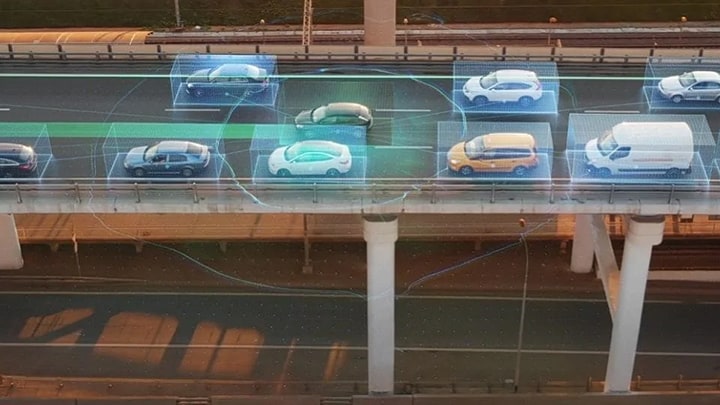We’ve all heard about the car of the future. You know, connected cars that were considered science fiction
just a few years ago. This is the car that sees around corners and over hills, detecting people, other cars and
even ice ahead. It syncs with traffic signals and zips you through green lights. It knows about an approaching
ambulance, pinpointing the location of the siren that you would otherwise only hear. This car helps you avoid
accidents, reduces congestion and minimizes emissions.
The future connected car, and ultimately the completely autonomous vehicle, isn’t so far away. On the streets
of Munich this week, NXP, Siemens, Cohda Wireless, Honda, DAF trucks and other partners are showing cars and
trucks that talk to traffic lights and each other. Called V2X (vehicle-to-everything) communications, our cars,
trucks and even ships and drones can connect and communicate to the intelligent traffic infrastructure and other
vehicles.
RoadLINK and the V2X connection
Here’s where NXP comes in — with its complete secure chipset for V2X, RoadLINKTM.
Unlike radar, optical, ultrasonic and lidar, RoadLINK can detect threats hidden from view, so it can extend its
awareness beyond what the driver can see. It’s a non-line-of-sight sensor with 360-degree awareness.
Messages are sent reliably at high speed between vehicles and the smart infrastructure — stop lights,
crosswalks and anywhere a roadside unit is placed — using IEEE802.11p, a low-latency wireless standard
designed to meet the stringent requirements of the automotive industry.
![Cohda]()
This is what a secure V2X communications box looks like. It’s the Cohda
Wireless MK5 based on the automotive-grade RoadLINK chipset from NXP.
Get the green light with V2X
Does it ever seem like your commute is in sync with a streak of green lights, or the opposite … red?
With V2X, your car and other vehicles on the road connect in real time with the traffic lights, exchanging messages
about proximity so the light can “extend” its green.
![_CC_1437]()
The Siemens smart traffic light exchanges automotive WiFi-based messages
with connected vehicles via NXP RoadLINK. The car display counts down the seconds to a yellow light
and also warns of an approaching ambulance and motorcyclist.
Vulnerable road users stand out with V2X
Pedestrians, cyclists or motorcycles, also known as vulnerable road users, can be “seen” with V2X. Once
detected, warnings are sent to cars in the area.
![DashHonda 750 p]()
Honda, equipped with Chemtronics solution based on RoadLINK V2X technology, cuts time
to react and communicates potential hazards and safety-critical scenarios significantly faster than conventional
applications.
![_CC_1449]()
With V2X, vehicles are also alerted of road signs ahead.
Emergency vehicles get priority with V2X
The siren wails, but you don’t see an ambulance. Then out of the blue, it’s right behind you. Or maybe
you don’t even hear it, until you see it in your rearview mirror waiting for you to pull over. With V2X,
your car tells you the location of the emergency vehicle before it’s within sight.
Fire engines, ambulances and other emergency vehicles also get a green light before they approach the intersection.
![_OMA0855]()
The light is red for this non-emergency vehicle, but when the ambulance approaches,
the light will change to green, allowing it to proceed through the light without stopping.
V2X road construction and accident warnings offer speed advice
Have you ever driven a long distance at a steady speed, and then suddenly come to a screeching halt because of road
construction or an accident on the roadway? This feature is for you. With cars communicating with cars, you get an
alert in advance – and suggestions on safe speed.
Trucks platoons increase safety and efficiency with V2X
Platooning can save fuel, increase road safety and cut down on emissions. With platooning, two trucks safely drive
bumper-to-bumper at high speeds. The second truck, the follower, is in a semi-autonomous driving state in sync with
the lead truck. The second truck follows the lead truck’s acceleration and braking autonomously through
RoadLINK technology combined with high-performance radar and vision systems.
![_CC_1287]()
Each of the DAF trucks have low-latency V2X antennas on the mirrors to connect with
each other.
![_OMA0706]()
The DAF trucks also connect with smart infrastructure, sharing 802.11p messages.
In this case, the Siemens stop light remains green to allow the second truck in the platoon to pass
through the light.
Fake emergency vehicles uncovered with V2X
Can a car ‘spoof’ an ambulance to get priority green lights?
Short answer: No.
With V2X, the system is secure and robust. Fast-moving 802.11p based RoadLINK messages are designed to connect
quickly anywhere, at any time in an ad hoc way. And NXP has an embedded secure element as part of its chipset
solution that authenticates all the back-and-forth fast-moving messages, ensuring secure encryption.
Even before an ambulance arrives at a smart traffic light, the light knows that it’s an emergency vehicle
because it has the right encryption key — and it has been signed properly. If the signature
doesn’t match the identity, it will not be given priority green light access.
From 802.11p car-to-car to LTE video streaming
Let’s say you’re part of a truck platoon. Your truck is not in the lead, so you can’t see
what’s in front of you. The lead truck can video stream what he’s seeing on the road. The stream,
running over 802.11p can play back to the trucks behind him, as well as over LTE to a remote location for viewing
and monitoring.
Technology for the secure, connected car is here
Connected cars can sense their environment and communicate with other vehicles and infrastructure, helping
you avoid accidents, reduce congestion and minimize emissions. How do you think autonomous vehicle
technologies will transform tomorrow’s driving experience?
* RoadLINK also supports Wi-Fi (802.11abgn) wireless standard, allowing to you upload and access data via home
Wi-Fi and hotspot connections.



